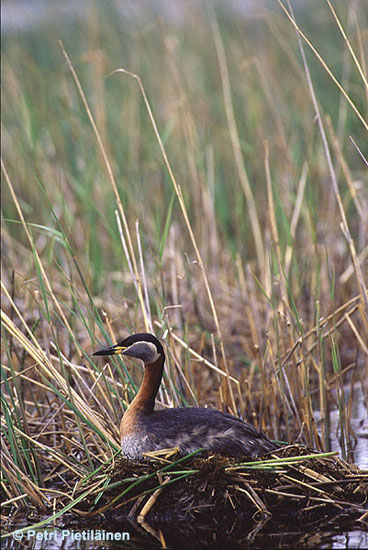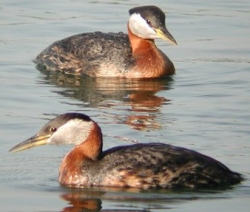
Social evolution in birds: The Evolution of colonial nesting
For my master's work I collaborated on an investigation of the evolutionary origin of colonial nesting in the red-necked grebe, Podiceps grisegena. Red-necked grebes are waterbirds that typically nest in a dispersed, territorial fashion, with rare instances of colonial nesting. These studies focused on a population of red-necked grebes in Minnesota that included both typical territorial nesting pairs as well as colonies of closely nesting pairs. We collected detailed census data on both colonial and territorial pairs over four breeding seasons. We compared fitness and other ecological data on colonial versus territorial nesters to better understand the benefits and costs of coloniality.
Both dispersed and colonial nesters co-occur sympatrically, so direct fitness comparisons are possible without confounding large scale ecological and geographic variation. Colonies occur on large offshore cattail islands, while territorial nesters are dispersed along shorelines and small cattail islets. Colonial nesting in the red-necked grebe may represent a recent evolutionary origin, or may be an alternative behavior that is only rarely expressed. Although the evolutionary history of this trait is in question, fitness comparisons of different social strategies nonetheless allow informative hypotheses testing about adaptive benefits. Concurrently, I developed microsatellite markers for this species and did a population genetic analysis.
Results: Red-necked grebes nesting at colony sites (large cattail islands) attained the highest fitness over four study years. Fitness, measured as as hatching success, was significantly higher for colonial pairs than territorial pairs nesting either on the shoreline or on small islets. Rates of nest failure (mostly due to wave destruction) were lower at the colony sites, and predation was lower in all islands, though only the former was consistently significant. Only marginal difference in predation rates between colonial and dispersed nests may represent a near balance between the former's protection from land predators (by open water) and its putative attraction of aerial predators (by increased conspicuousness). Microsatellite data suggest that no genetic structure exists in the population, and that kin selection is not at work at the colony. Rates of reproductive conflict (evidence of extra-pair fertilizations and brood parasitism) were higher for colonial individuals, but these data were scant. Fitness differences rule out an ideal-free distribution, and lack of size differences, in either sex or combined, suggests against a despotic distribution or a hidden lek. We conclude that colonial individuals gain fitness benefits from rare, high quality habitat, with no benefits being attributed solely to the aggregation of conspecifics.Background: Recent work on the evolution of coloniality has emphasized the importance of benefits reaped from conspecifics. Many studies on this topic have examined species that are anciently colonial, however; where secondary adaptations that maximize the benefits and minimize the costs of social living are expected. These secondary adaptations may confound direct examination of the evolutionary origin of coloniality. Early theory on coloniality suggested that its evolution could be divided into three stages. Stage I is the ancestral condition, solitary territorial nesting. Stage II is characterized by a great reduction in breeding territory with only rare and weak social interactions. In Stage III, there is a minimization of costs and a maximization of benefits of social living (Siegel-Causey and Kharitonov Current Ornithology Vol 7 1990). Studies of anciently colonial species, in which the benefits of coloniality are correlated with colony size, may confound the origin and the maintenance of coloniality.
Significance: The final phase of our study analyzes the selective forces behind the evolution of coloniality in red-necked grebes. Adaptive benefits of coloniality may be divided into two general types: proximity benefits are the gained by colonial individuals simply from the presence of conspecifics, whereas habitat benefits are gainsed solely from the resources available at the colony site. This portion of the study separately analyzes these two types of benefits to directly test their importance in the evolutionary origin of coloniality (in preperation, below).
Publications:
Sachs, J. L. 1998. The Evolutionary Origin of Coloniality: A Test of Hypotheses with the Red-
necked Grebe. Masters Thesis. University of North Dakota.Sachs J. L. and Hughes C. R. 1999. Characterization of microsatellite loci for the red-necked grebe Podiceps grisegena. Molecular Ecology 8:687-688 PDF
Nuechterlein, G. L., Buitron, D., Sachs, J. L., Hughes, C. R. 2003. Red-necked grebes become semicolonial when prime nesting habitat is available. The Condor 105:80-94. PDF
In Preperation:
Sachs, J. L., Hughes, C. R., Nuechterlein, G. L., Buitron, D. The Evolutionary origin of colonial nesting; A Test of hypotheses with the red-necked grebe, Podiceps grisegena.



